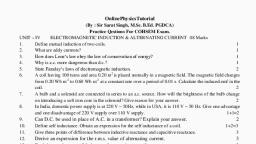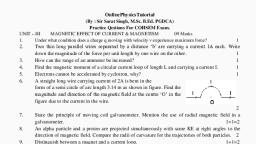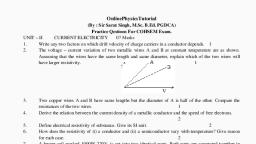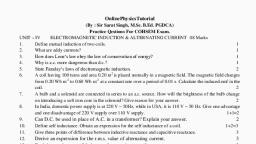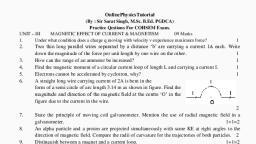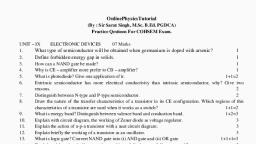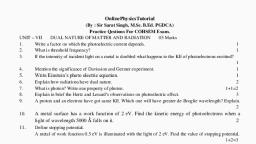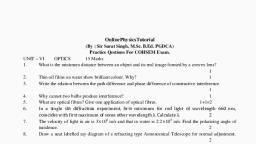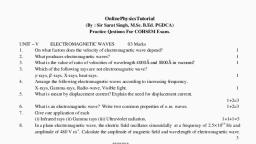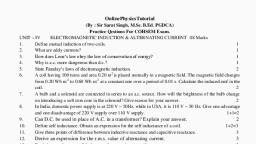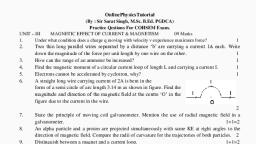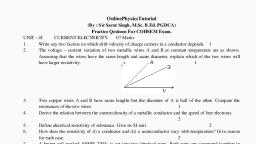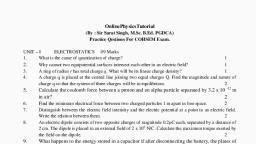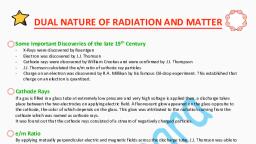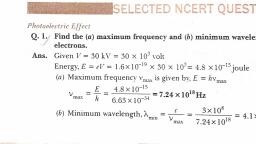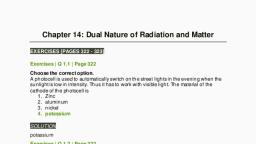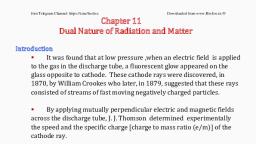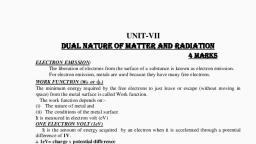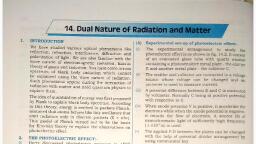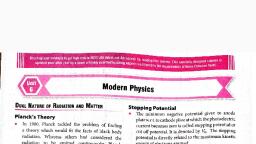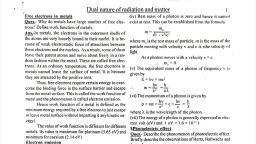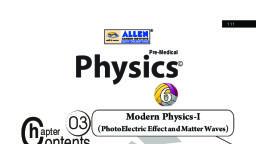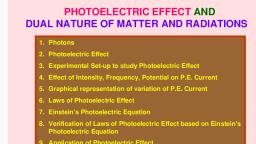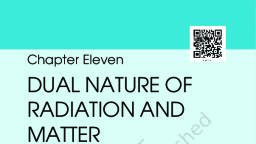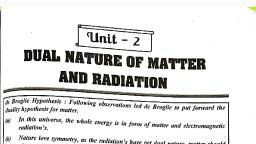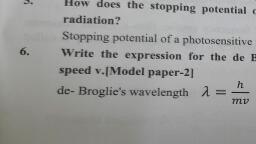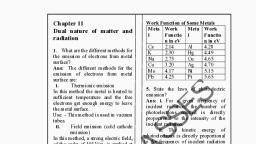Page 1 :
XII Sc. Physics Notes- (Unit VII – Dual Nature of Radiation & Matter) – by Sir Sarat, TG Hr.Sec.School, Dual Nature of Radiation :, Wave theory of e. m. radiation can explain some phenomena such as interference, diffraction, and polarisation by treating light as a wave. But many phenomena like photoelectric effect, Compton, effect, black body radiation, X – ray spectra etc. can not be explained by wave theory of light. Such, phenomena are successfully explained by quantum theory of e. m. radiation by treating radiation as, particle-like packages of definite energy called “light quanta” or “photons”. This shows that radiations, have dual nature i.e. both wave and particle natures., PHOTOELECTRIC EFFECT :, The phenomenon of emission of electrons from (preferably) metal surface, when light energy of, suitable frequency, falls on it, is known as photoelectric effect., The emitted electrons are called photoelectrons and the current so produced is called, photoelectric current., Alkali metals like lithium, sodium, potassium, caesium etc. show photoelectric effect with visible, light, whereas the metals like zinc, cadmium, magnesium etc. are sensitive only to ultraviolet light., , Hertz’s Observation of Photoelectric Effect :, Photoelectric effect was first discovered by German physicist, Heinrich Rudolf Hertz, in 1887, while studying experimentally the production of e.m. waves using two metal plates (electrodes) applied, with a voltage across them. Hertz observed that when the metal plate at negative potential (i.e cathode, / emitter plate) was illuminated by uv- radiations, high voltage sparks across the plates became more, enhanced or intensified. This observation led him to conclude that UV- light fascilitated the emission of, some negatively charged particles (i.e. electrons) from the metal plate. This was the first observation of, the photoelectric effect., , Hallwachs’ and Lenard’s Observations on Photoelectric Effect :, Wilheim Hallwachs and Philipp Lenard studied in detail the phenomenon of photoelectric effect, during 1886 – 1902., Lenard’s Observations : Philipp Lenard observed the flow of current in an evacuated glass tube, enclosing two metal plates (electrodes) applied with a potential difference / voltage across them., (i) He observed that no current flows in the circuit when a, potential difference is applied across the plates of the, evacuated glass tube if no incident light/radiation falls on, the plates., (ii) He observed that when one of the plates, kept at negative, potential, is illuminated by UV- light, the current in the, circuit begins to flow in the circuit., These observations indicate that negatively charged particles (i.e. electrons) are emitted from, the metal plate UV- light falls on it., , Hallwachs’ Observations :, Wilheim Hallwachs observed that, (i) When a negatively charged zinc plate was illuminated by UV- radiations, it lost its negative charges., (ii) An uncharged zinc plate got positively charged when it was illuminated by UV – radiations., (iii) The positive charges of a positively charged zinc plate became enhanced or increased when, exposed to Uv – radiations., These observations indicate that negatively charged particles (electrons) are emitted from the zinc, plate when exposed to UV- radiations., Hallwachs and Lenard further studied the variations of photocurrent with anode/ collector, potential and with frequency and intensity of incident radiations. They observed that if the frequency of, the incident radiation was smaller than a certain minimum value called threshold frequency, no, emission of electrons took place from the metal plate at negative potential.
Page 2 :
XII Sc. Physics Notes- (Unit VII – Dual Nature of Radiation & Matter) – by Sir Sarat, TG Hr.Sec.School, Laws of Photoelectric emission :, 1., If the frequency of the incident radiation is lower than a certain minimum frequency, called, threshold frequency, no photoelectric emission takes place for a given metal., 2., The number of photoelectrons emitted (or the photoelectric current), is directly proportional, to the intensity of incident radiation (above the threshold frequency for a given metal). (It does not, depend upon the frequency of the incident radiation)., 3., The maximum Kinetic energy (or maximum velocity or stopping potential) of the emitted, photoelectrons depend upon the frequency of the incident radiation but not on the intensity.[ i.e. the, maximum K.E. of the photoelectrons increases linearly with the frequency of the incident radiation but, it is not a function of intensity], 4., The photoelectric emission is an instantaneous process. [ i.e. photoelectric emission starts as, soon as the incident radiation falls on the metal surface even when the incident radiation is extremely, dim.], Threshold frequency :, The minimum value of frequency of incident radiation below which photoelectric, emission/effect, does not take place for a given metal, is called threshold frequency., Threshold frequency is different for different materials., Threshold wavelength :, The maximum value of wavelength of incident radiation above which photoelectric, emission/effect, does not take place for a given metal, is called threshold wavelength., Threshold wavelength is different for different materials., Stopping potential, The minimum value of opposing potential difference required so as to just stop the, photoelectron emitted with maximum kinetic energy, is called stopping potential., It is the minimum negative potential of the anode (w.r.t. the cathode) (in a photocell) at which, the photocurrent is just reduced to zero., If Vo = stopping potential, then maximum K.E. of photoelectron must be equal to the energy, acquired by it while passing through the p.d. Vo., i.e., K.E.max = e Vo, Work function :, The minimum energy required by a free electron to come out of a metal surface (against the, surface barrier), is known as work function of the metal., Work function of a metal, is defined as the minimum value of energy required so as to just eject, the photoelectron from the metal., It is different for different materials. The work function of metal depends upon, (i) nature of metal (ii) condition of the surface of metal (iii) impurities present in the metal, If 𝑓𝑜 = threshold frequency for a given metal, then work function, ∅𝑜 = ℎ𝑓𝑜, Prob. How does photoelectric effect support the particle nature of light ? Explain., Soln. Photoelectric effect supports the particle nature of light because of the following reasons :, (i) Photoelectric effect/emission does not take place at all if the frequency of incident light is, lower than a certain minimum frequency called threshold frequency, irrespective of the intensity of, incident light., (ii) Photoelectric effect/emission is exactly an instantaneous process and has no time delay.
Page 3 :
XII Sc. Physics Notes- (Unit VII – Dual Nature of Radiation & Matter) – by Sir Sarat, TG Hr.Sec.School, Graphical Relationships :, 1., Photoelectric current(i) V/s Intensity of radiation(I) :, photoelectric current (i) ∝ Intensity (I), , 2., , Photoelectric current(i) V/s Anode potential(V) for different Intensity:, , This graph indicates that stopping potential (or, max. K.E) is independent of the intensity of, incident radiation., , 3., , Photoelectric current(i) V/s Anode potential(V) for different Frequency :, , This graph indicates that stopping potential, increases with the increase in frequency of, incident radiation., , 4., , Stopping potential(Vo) V/s. Frequency(f) :, , Stopping potential (Vo) increases linearly with, the frequency of incident radiation.
Page 4 :
XII Sc. Physics Notes- (Unit VII – Dual Nature of Radiation & Matter) – by Sir Sarat, TG Hr.Sec.School, 5., , Maximum K.E.(Kmax) V/s. Frequency(f) :, , The graph of Kmax versus f should be a, straight line., The slope of the graph = tan 𝜃 = h (Planck’s, constant), OA= fo (threshold frequency of metal I), OA’ = f ‘o (threshold frequency of metal II), 𝑂𝐵 = ∅(work function of metal I), 𝑂𝐵′ = ∅′(work function of metal II), , Photon :, A packet of definite energy of an e. m. radiation, is called a photon. The energy of a photon is, given by 𝐸 = ℎ𝝂, where, h = Planck’s constant = 6.62× 10−34 J.s ;, ν = frequency of the photon or radiation, If λ = wavelength of the photon or radiation, then c =νλ, ∴, , E=, , ℎ𝑐, 𝜆, , Properties of photon :, 1., A photon travels with the speed of light in vacuum (i.e. 3 × 108 m/s)., 2., The rest mass of photon is zero. It means that photon can not exist at rest., 3., , The kinetic mass of photon is given by m =, , 4., , The momentum of a photon is, p =, , 5., 6., , They are electrically neutral., The energy of photon is completely kinetic., , 𝐸, 𝑐, , =, , ℎ𝜈, 𝑐, , 𝐸, 𝑐2, , =, ℎ, , ℎ𝜈, 𝑐2, , ℎ, , = 𝑐𝜆, , =𝜆, , Einstein’s Photoelectric Equation :, According to Einstein, when a photon of energy E = hν , is incident on a metal, the energy is, used in two ways –, (i) a part of this energy is used for the required work function (∅) and, (ii) the rest of energy is given to the photoelectron as max. kinetic energy(Kmax)., Thus, according to Einstein,, E = ∅ + Kmax, If ν = frequency of the incident photon , v max = maximum velocity of photoelectron; ν o = threshold, frequency, then Einstein’s photoelectric equation becomes, hν = ℎ𝜈𝑜 +, or,, , ℎ𝑐, 𝜆, , 1, mv𝑚𝑎𝑥 2, 2, , = ∅ + 𝑒𝑉𝑜 where λ = wavelength of incident photon, Vo = Stopping potential, , Prob. The maximum K.E. of photoelectrons emitted from a surface, when photons of energy 6 eV falls, on it is 4 eV. What is the stopping potential for the fastest photoelectrons?, Soln. We have,, eVo = Kmax = 4 eV, ∴, Vo = 4 V
Page 5 :
XII Sc. Physics Notes- (Unit VII – Dual Nature of Radiation & Matter) – by Sir Sarat, TG Hr.Sec.School, Prob. Light of wavelength 2000 Å falls on a metallic surface whose work function is 4.21 eV. Calculate, the stopping potential., Soln. We have,, E = ∅ + Kmax, ℎ𝑐, , ⇒, , 𝜆, , = ∅ + 𝑒𝑉𝑜, , =, , ℎ𝑐, , ∅, , 6.62×10 −34 ×3×10 8, , 𝑒, , 1.6×10 −19 ×2000 ×10 −10, , − =, , ⇒, , 𝑉𝑜, , ∴, , 𝑉𝑜 = 6.21 − 4.21 = 2 V, , 𝑒𝜆, , − 4.21, , Matter Wave or de- Broglie wave :, The wave associated with a moving material particle, is called “ matter wave” or “de Broglie, wave”., The wavelength of the wave associated with a moving material particle is called “de Broglie, wavelength”, Matter wave is neither e. m. wave nor mechanical wave :, Matter wave can travel in vacuum like e. m.wave. Hence, it is not a mechanical wave. Moreover, matter, waves are not e. m.waves because they are not produced by accelerated charged particle. Matter waves, are produced by moving material particles whether charged or uncharged., To Derive de Broglie wavelength (λ) :, According to quantum theory of radiation, energy of a photon is given by, E = hν, . . . (i), According to Einstein’s mass – energy equivalence, energy of photon is given by, E = mc2, . . . (ii), By (i) and (ii), we get,, mc2 = hν =, ∴, , λ=, , ℎ, , ℎ𝑐, 𝜆, , where λ = de Broglie wavelength of photon, . . . (iii), , mc, , If instead of photon, we have a material particle of mass m moving with velocity v, then eqn. (iii), becomes, λ=, , ℎ, mv, , which is de Broglie wavelength., , de Broglie wavelength in term of K.E :, Kinetic energy(E) of a particle of mass m moving with velocity v, is given by, 1, 2, , E = mv 2, ∴, , mv = 2mE, , ∴ de – Broglie wavelength, λ =, , ℎ, 2mE, , de – Broglie wavelength(λ) of electron accelerated through potential difference V :, Consider an electron accelerated through a potential difference V. Then the kinetic energy, acquired by the electron will be given by, 1, 2, , E = mv 2 = 𝑒V, ∴ mv = 2mE = 2m𝑒V, Then, de – Broglie wavelength of the electron will be given by, λ=, , ℎ, 2meV
Page 6 :
XII Sc. Physics Notes- (Unit VII – Dual Nature of Radiation & Matter) – by Sir Sarat, TG Hr.Sec.School, putting the values, ℎ = 6.62 × 10−34 Js ;, we get,, , 6.62×10 −34, , λ=, , ∴, , m = 9.1 × 10−31 kg ; 𝑒 = 1.6 × 10−19 C ;, , 2×9.1×10 −31 ×1.6×10 −19 V, λ=, , 12.27, V, , m, , Å, , Prob. A photon and an electron have got same de-Broglie wavelength. Which one has greater total, energy? Explain with calculation., Soln., , Energy of a photon, Ep = hν =, , ℎ𝑐, , . . . . (i), , 𝜆, , Again, Energy of an electron, Ee = mc2, But, de Broglie wavelength, λ =, ∴, , m=, , ℎ, , ℎ, , where, v = velocity of electron, , mv, , λv, , Thus, Energy of an electron, Ee =, , ℎ, λv, , c2, , . . . . (ii), , Deviding (i) by (ii), we get, , 𝐸𝑝, 𝐸𝑒, , ∴, , =, , ℎ𝑐, 𝜆, , 𝜆𝑣, , 𝑣, , × ℎ𝑐 2 = 𝑐 < 1, , [∵ c> v ], , 𝐸𝑒 > 𝐸𝑝, , Thus, electron has greater total energy., DAVISSON AND GERMER EXPERIMENT :, Davisson and Germer performed an experiment, in 1927 to verify the wave nature of electron., In the experiment, they observed the intensity of, the accelerated electron beam after diffraction, from a nickel crystal. The intensity of diffracted, or scattered electron beam from the nickel, crystal, was found maximum at the scattering or, diffracting angle of 50°, when the accelerating, voltage of electron beam was at 54 V., At scattering angle 𝜃 = 50° and accelerating voltage V = 54 V, they found as follows :, , Thus, Davission and Germer, verified the wave nature of moving electron, i.e. de Broglie hypothesis.
Page 7 :
XII Sc. Physics Notes- (Unit VII – Dual Nature of Radiation & Matter) – by Sir Sarat, TG Hr.Sec.School

